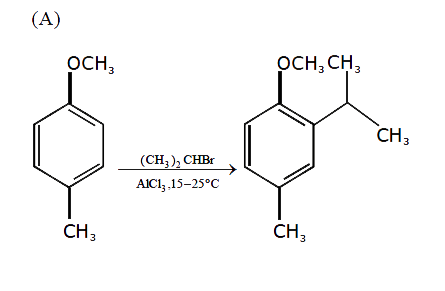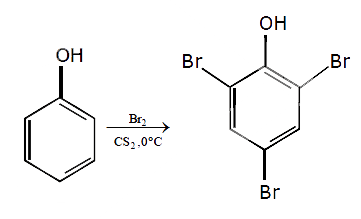It is not always easy to predict the position of attack on multiply substituted benzene. If the benzene ring bears different group ortho/ para di- recting group at the 1 and 4 positions, the position of further substitution is not immediately clear.
Which of the following side chain reaction/s can be used to reduce the activity of strongly activat- ing groups like – OH
benzoylation ⎛⎜ ⎜⎝Ph−O||C−⎞⎟ ⎟⎠
acetylation ⎛⎜ ⎜⎝CH3−O||C−⎞⎟ ⎟⎠
both of the above
none of the above
The correct Answer is:C
To solve the problem regarding the reduction of the activity of strongly activating groups like –OH in a multiply substituted benzene, we can follow these steps:
1. Identify the Problem: We have a benzene ring with a strongly activating group (–OH) at one position and a para-directing group at another position. The goal is to reduce the reactivity of the –OH group to achieve mono-substitution rather than tri-substitution.
2. Understanding the Directing Effects: The –OH group is an ortho/para-directing group, which means it increases the electron density at the ortho and para positions of the benzene ring. This increased electron density makes these positions more reactive towards electrophilic substitution.
3. Protecting the –OH Group: To reduce the reactivity of the –OH group, we can use protection strategies. This involves converting the –OH group into a less reactive substituent that does not direct electrophilic attack.
4. Using Benzoylation: One method to protect the –OH group is by benzoylation. In this reaction, the –OH group is converted into a benzoyloxy group (–OCOPh). This transformation reduces the availability of the lone pair on oxygen for resonance with the benzene ring, thus decreasing its activating effect.
5. Using Acetylation: Another method is acetylation, where the –OH group is converted into an acetoxy group (–OCOCH3). Similar to benzoylation, this reduces the electron-donating ability of the –OH group, making it less reactive in electrophilic aromatic substitution.
6. Conducting the Electrophilic Substitution: After protecting the –OH group, we can carry out the electrophilic substitution reaction (e.g., bromination) on the benzene ring. Since the –OH group is now less activating, we can achieve mono-substitution at the desired position.
7. Final Product: The final product will be a mono-substituted benzene derivative, where the original –OH group has been protected, allowing for controlled substitution.
Conclusion:
By using benzoylation or acetylation to protect the –OH group, we can effectively reduce its reactivity and achieve mono-substitution on the benzene ring.
By using benzoylation or acetylation to protect the –OH group, we can effectively reduce its reactivity and achieve mono-substitution on the benzene ring.
Topper's Solved these Questions
- AROMATIC COMPOUNDBOOK - MOTIONCHAPTER - AROMATIC COMPOUNDEXERCISE - Exercise - 4 | Level-I
13 Videos
- AROMATIC COMPOUNDBOOK - MOTIONCHAPTER - AROMATIC COMPOUNDEXERCISE - Exercise - 4 | Level-II
16 Videos
- AROMATIC COMPOUNDBOOK - MOTIONCHAPTER - AROMATIC COMPOUNDEXERCISE - Exercise - 2 (Level-II)
29 Videos
- ALKYI HALIDEBOOK - MOTIONCHAPTER - ALKYI HALIDEEXERCISE - Exercise - 4 | Level-II
8 Videos
- ATOMIC STRUCTURE BOOK - MOTIONCHAPTER - ATOMIC STRUCTURE EXERCISE - EXERCISE-4 (LEVEL-II)
18 Videos
Similar Questions
It is not always easy to predict the position of attack on multiply substituted benzene. If the benzene ring bears different ortho//para directing group at the 1 and 4 positions, the position of further substitution is not immediately clear. Sometimes steric effects determine the outcome. In other cases, electronic factors determine the outcome, and further reaction will be at the position activated by the more strongly activating group.
Some substituens are so strongly activating that no catalyst is needed, and it is often diffcult to stop substitution after mono substituion. Mild condition are needed to restrict the reaction to mono-substitution.
It is possible to reduce the activity such groups by side chain reaction so that the reaction can be stopped use can sometimes be made of removable blocking groups on the ring.
Which of the following synthesis could be done in the ring step ?
View SolutionIt is not always easy to predict the position of attack on multiply substituted benzene. If the benzene ring bears different ortho//para directing group at the 1 and 4 positions, the position of further substitution is not immediately clear. Sometimes steric effects determine the outcome. In other cases, electronic factors determine the outcome, and further reaction will be at the position activated by the more strongly activating group.
Some substituens are so strongly activating that no catalyst is needed, and it is often diffcult to stop substitution after mono substituion. Mild condition are needed to restrict the reaction to mono-substitution.
It is possible to reduce the activity such groups by side chain reaction so that the reaction can be stopped use can sometimes be made of removable blocking groups on the ring.
Which of the following is the correct major product ?
View Solution
Knowledge Check
It is not always easy to predict the position of attack on multiply substituted benzene. If the benzene ring bears different group ortho/ para di- recting group at the 1 and 4 positions, the position of further substitution is not immediately clear.
Which of following is the incorrect major product ?A B
B C
C D
D
It is not always easy to predict the position of attack on multiply substituted benzene. If the benzene ring bears different group ortho/ para di- recting group at the 1 and 4 positions, the position of further substitution is not immediately clear.
Which of the following synthesis could be done in the single step ?A B
B C
C D
D
It is not always easy to predict the position of attack on multiply substituted benzene. If the benzene ring bears different ortho//para directing group at the 1 and 4 positions, the position of further substitution is not immediately clear. Sometimes steric effects determine the outcome. In other cases, electronic factors determine the outcome, and further reaction will be at the position activated by the more strongly activating group.
Some substituens are so strongly activating that no catalyst is needed, and it is often diffcult to stop substitution after mono substituion. Mild condition are needed to restrict the reaction to mono-substitution.
It is possible to reduce the activity such groups by side chain reaction so that the reaction can be stopped use can sometimes be made of removable blocking groups on the ring.
Which of the following side reaction//s can be used to reduce the activity of strongly activating groups like −OH ?AbenzcylationBacetylationCboth of the aboveDnone of the above
Which of the following side chain reaction/s can be used to reduce the acitivating group such as (−OH) or (−NH2).
View SolutionIt is not always easy to predict the position of attack on multiple substituted benzene. If the benzene ring bears different ortho/para directing group at the 1 and 4 position, the position, the position of further substitution is not immediately clear. sometimes steric effect determine the outcome. in other cases, electronic factors determine the outcome, and further reaction will be at the position activated by the more strongly activating group. Some substituents are so strongly activating that no catalyst is needed to restrict the reaction to mono-substitution. It is possible to reduce the activity of such groups (by side chain reaction) so that the reaction can be stopped after mono substitution then and again by a side cahin reaction the original group is restored. effective use can sometimes be made of removable blocking groups on the ring.
Q. Which of the following synthesis could not be done without involving blocking position on the ring?
View SolutionIt is not always easy to predict the position of attack on multiple substituted benzene. If the benzene ring bears different ortho/para directing group at the 1 and 4 position, the position, the position of further substitution is not immediately clear. sometimes steric effect determine the outcome. in other cases, electronic factors determine the outcome, and further reaction will be at the position activated by the more strongly activating group. Some substituents are so strongly activating that no catalyst is needed to restrict the reaction to mono-substitution. It is possible to reduce the activity of such groups (by side chain reaction) so that the reaction can be stopped after mono substitution then and again by a side cahin reaction the original group is restored. effective use can sometimes be made of removable blocking groups on the ring.
Q. Which of the following is the correct major product?
View SolutionA group which deactivates the benzene ring towards electrophilic substitution but directs the incoming group towards o- and p- position is
View SolutionWhich of the following stes of groups activates the ortho and para positions in electrophilic aromatic substitutions ?
View Solution
